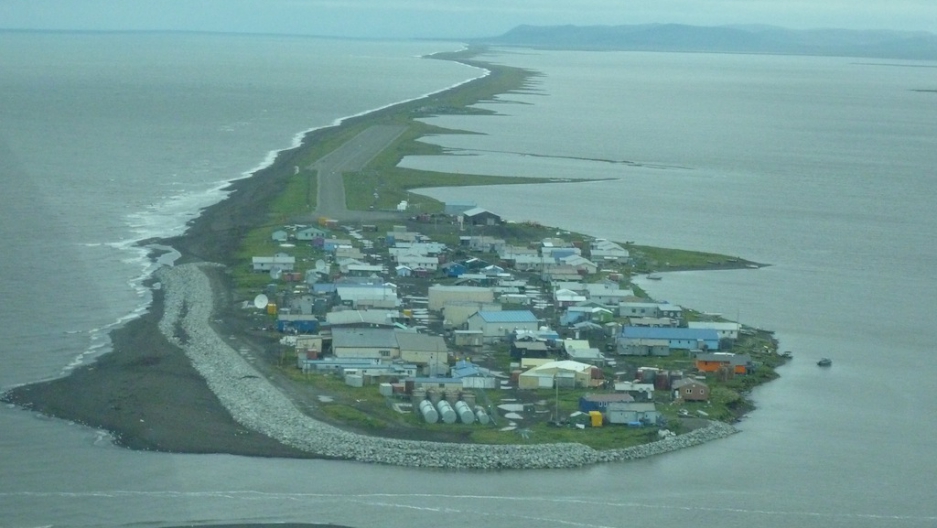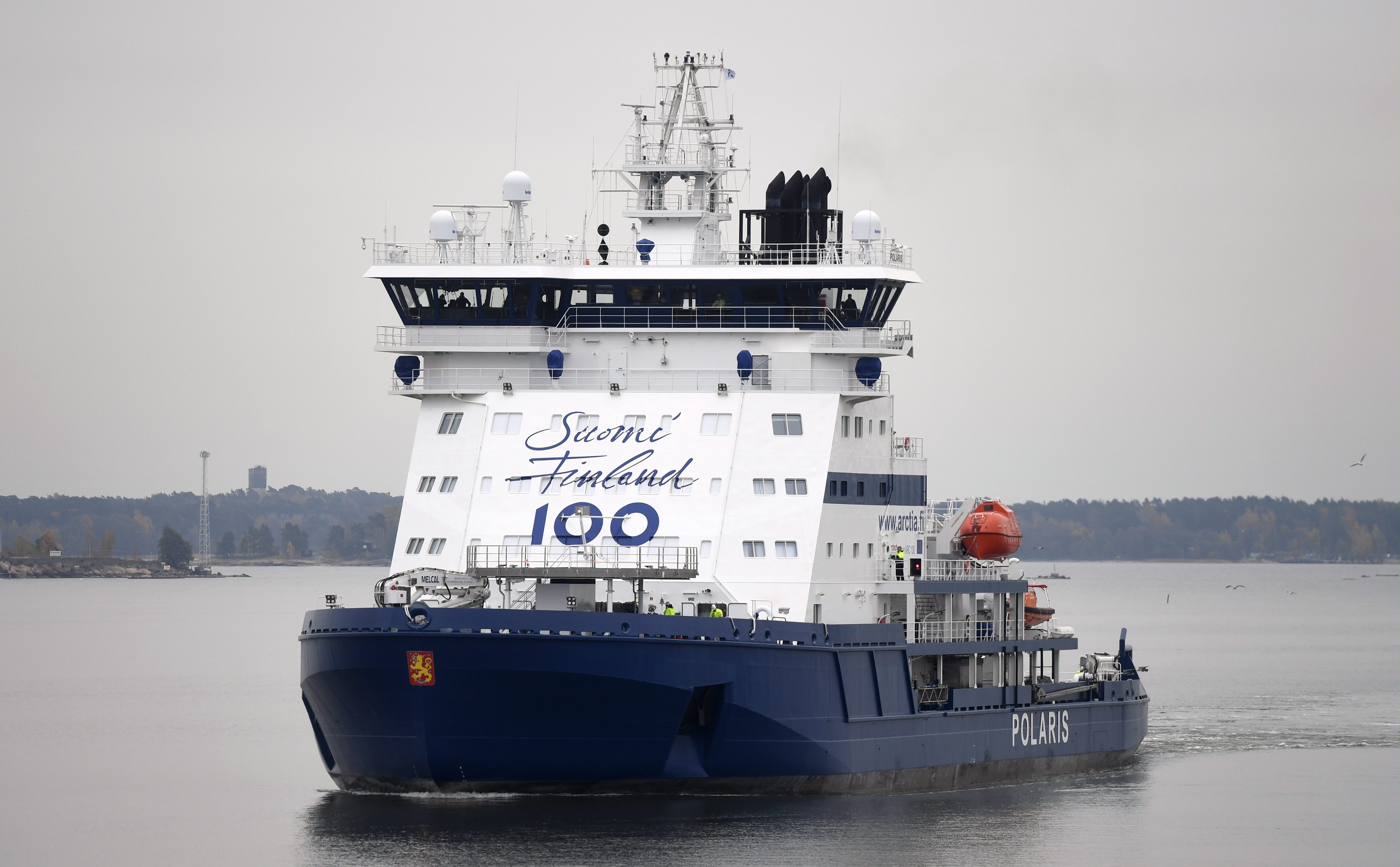The Week Ahead: Saving Kivalina
The Week Ahead is a preview of some of the events related to the region that will be in the news in the coming week. If you have a topic you think ought to be profiled in a coming week, pleasene**@ar*******.com“> contact us.
This week, the public will get its chance to provide input on plans to build an evacuation route for the climate-threatened Arctic village of Kivalina, Alaska.
For most of its history, Kivalina (population 400) has been an advantageous location for the Iñupiat whale hunters who live there. In the past, the sea ice that formed around the barrier island along Alaska’s northwestern coast made it possible for residents to support themselves by hunting bowhead whales.

As sea ice has declined, Kivalina has been hit doubly hard: At the same as whaling has become less safe, the island has been robbed of protection from the heavy seas that are churned up by increasingly powerful winter storms in the Chukchi Sea.
Efforts have already been made to reinforce the island, but scientists predict that the narrow stretch of land where Kivalina is situated will succumb to erosion, perhaps within the next decade.
The community has been working with local, state and federal authorities on the all-but-impossible task of finding a relocation solution that is both culturally acceptable and fiscally feasible. (The estimated cost of moving the village is as high as $400 million.)
While people continue to live in Kivalina, the immediate concern is how to evacuate them in the event of a major storm. An October 2007 storm give an idea of what they need to prepare for. At that time, the island was inundated by debris-laden storm surge that rendered the airstrip, its only connection to the mainland, unusable. Instead, residents had to be flown out by helicopter.
The incident “illustrated that Kivalina currently has no safe method of evacuation in the event of a catastrophic storm surge,” the state Department of Transportation noted in a report published in November containing proposals for an evacuation route.
The Dec. 5 meetings, being held in Kivalina and two other locations, will seek to identify which of the routes would suit the community best.
The evacuation route, a road that will connect the island to the mainland, has been proposed as a temporary solution, but the state has also left open the possibility of not building a route at all.
While this would eliminate any environmental impact, as well as the possibility of damage to cultural or historical sites, the report finds this would leave the community “exposed to environmental threats” and “without reliable options for evacuation during storm events.”
The proposed routes will offer the people of Kivalina a road to higher ground, but, before long, it may become necessary to move the village in order to save it.
Greenland’s blue belt
The coming week will also see legislators in Denmark considering environmental questions when the Folketing, the national assembly, discusses the final changes to legislation that would offer new legal protection to exclusive economic zone (between three and 200 nautical miles from the coast) around Greenland.
Greenland’s EEZ remains under Danish control and the current set of regulations dates from 2004. But with increasing activity in the region, Copenhagen is interested in coming up with new guidelines.
Should the measure pass in the Folketing on Wednesday, it would result in the first law specifically aimed at protecting Greenland’s maritime areas. In addition to regulations for shipping and environmental response, the bill seeks to clarify which authorities have jurisdiction over specific tasks.
The legislation would also recognize that authority over Greenland’s raw materials was devolved to Nuuk in 2010.
Window on the North
On the conference circuit, the seventh annual Arctic: Today and Future runs from Dec. 4-6 in St. Petersburg, Russia.
In many ways, the meeting, which is expected to attract over 1,000 people, looks like a lot of the other gatherings about the region. Presentations about transport, technology, the environment and economic development pepper the agenda, but the focus on Russian accomplishments in the region during the past year, as well as on Moscow’s intentions for 2018, make the gathering of particular interest for those with an interest in the region. As in past years, proceedings of the meeting will also be written up and sent to the Kremlin in order to give decision makers a foundation for planning for the region, according to the organizers.
This year’s meeting also features the participation of Dmitry Rogozin, the often-bellicose vice prime minister and head of the State Commission for Arctic Development.
In addition to addressing the gathering about the commission’s priorities, Rogozin is also due to head a meeting of the commission in St. Petersburg.
Other events and issues

Finland 100
Finland celebrates its centenary as an independent state on December 6. Celebrations have been taking place all year, and the occasion is being used to promote the work of the country’s Arctic Council chairmanship in 2017 and 2018. Most visible were the launch of the Polaris, an icebreaker, and the staging of an expedition through the Northwest Passages this past summer.
Canada in China
On Sunday, Justin Trudeau began a five-day visit to China, his second since taking office.
Official statements ahead of the trip do not mention the Arctic specifically. China, however, is playing an ever-larger role in the region, and Canada is no exception. In 2015, Beijing expressed interest in establishing its own research station in Nunavut or the Northwest Territories. In 2016, it established guidelines for sailing the Northwest Passages, before its state-operated icebreaker, the Xue Long, completed a research voyage there this past summer.
Even without an Arctic angle to the trip, an economic focus could benefit the North, particularly in areas like tourism and resource extraction. During a similar visit by Donald Trump earlier this year, the American president witnessed the signing of an agreement that could see Chinese money being used to develop Alaska’s natural gas resources.
The E-word
Canada’s Inuit face a range of serious problems: inadequate housing, food insecurity and high rates of suicide are just a few. Is the name of an Edmonton football team one of them?
Calls for the team to change its name to something other than ‘Eskimo’ have cropped up in the past, but seemed to gain more momentum recently in connection with a big game two weeks ago, when a number of voices, including Inuit advocates and the Toronto Star, a major news outlet, called for the team to change its name. Asked by a news outlet at the time, Natan Obed, the chair of ITK, which is charged with representing Canada’s Inuit, accepted that not all Inuit find the term offensive, but noted that the entire community suffered when some of its members were hurt by it.
Edmonton lost the game and its season ended, but the debate about its name has continued, most recently with an op-ed in Nunatsiaq News, a Nunavut news outlet and Arctic Now partner, arguing that the name is a “racial slur” that perpetuates colonial thinking.
Slippery rally
With the price of oil rallying in recent weeks, combined with moves in Washington that signal a more welcoming approach to Arctic drilling, proponents of Arctic oil are eyeing a brighter future.
However, a recent Canadian court decision would seem to pose a setback for resource extraction in the Yukon, while a recent op-ed published by The Hill, a Washington political news outlet, suggests that, at least for the time being, the price of oil is unlikely to reach the level needed to make Arctic drilling profitable.
Monthly sea-ice report
The first week of the month typically sees the release of monthly sea-ice data from the Colorado-based National Snow and Ice Data Center. The data for October showed that sea-ice levels remained near record lows.
Arctic Imagination
On Dec. 5, author Naomi Klein headlines the second installment of the Arctic Imagination series to be held by the New York Public Library. The event will be livestreamed for those who cannot attend in person.
Emergency Prevention, Preparedness and Response
The Arctic Council’s Emergency Prevention, Preparedness and Response working group holds a regularly scheduled meeting from Dec. 6-8 in Copenhagen. The EPPR addresses various aspects of prevention, preparedness and response to environmental emergencies in the Arctic.